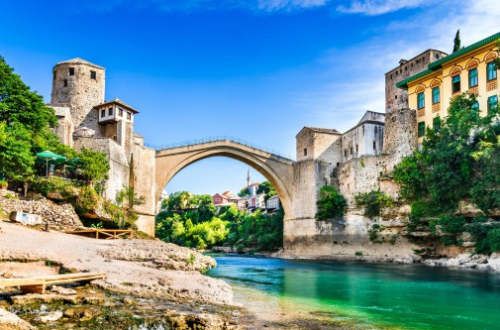

 Mostar
MostarWe disembarked and were eventually on our way inland to Bosnia-Herzegovina where we visited the ancient city of Mostar. Mostar is situated on the Neretva River and is the fifth-largest city in the country. Mostar was named after the bridge keepers (mostari) who in the medieval times guarded the Stari Most (Old Bridge) over the river Neretva. The bridge was destroyed in the Croatia-Bosnia conflict but has been painstakenly rebuilt using the original stones and proved well worth the visit.
The local lads earn a crust by jumping from the top of the bridge into the river some 24 meters below. It seemed to be the case of 'how much can I collect from the tourists before I have to make this jump' but personally I wouldn't have tried it for twice what they earned.
The old town has many markets and the trip included a visit to a Turkish house and a Muslim Mosque. We had a very nice meal before finally returning to the coach for the onward trip to Dubrovnik to our first main hotel where we were due to stay for 4 nights which after all the travelling was to be a welcome rest.
 Dubrovnik
DubrovnikThe Baba Kuk Valamar Club is a modern hotel with a large outdoor pool and evening entertainment. The rooms were very comfortable and we had a great view from our window overlooking the entry to the port of Dubrovnik; this hotel proved a great place to stay whilst we toured Dubrovnik and the surrounding area.
Dubrovnil has at various times in its history been occupied by Rome, Venice, Austria, Turkey, France and the architecture reflects the different cultures. The walls built in between the 12th and 17th centuries are around 2kms long and built to keep out the pirates; we walked the best half around the sea facing part (don't look down!) and made it back to the centre just in time to take refuge in a nice little bar before the heavens opened. We were just glad not to be caught on the walls during the downpour. Fortuitously, this proved to be the only rain we encountered during our holiday and we spent it eating and drinking in the bar.
The Dubrovnik's City Bell Tower is a very unusual clock located in the main square of the old town; originally built in 1444 it has a face with an hour hand but no minute hand and two rotating drums below which display the hour (roman) and the minutes (western). Two bronze figures, the bell strikers, locally called Maro and Baro ring the antique chiming bells every day at noon.
Over the course of the three days we spent in Dubrovnik, in addition to the trips out, we also had a very relaxing time in the hotel, by the pool or in the bar and every night there was live entertainment in the pool-side nightclub.